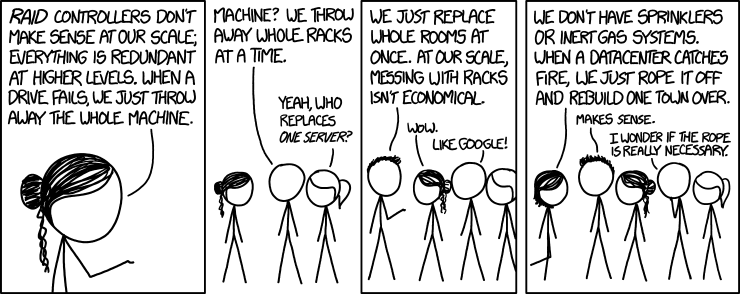In data analytics, scalability is a cornerstone that determines the long-term success and efficiency of data platforms. As organizations grow, so does the volume of their data and the complexity of their analytics needs. Ensuring scalability means designing a system capable of handling increasing loads gracefully, improving performance, and facilitating seamless expansion. For some people, this can be a new challenge to solve, especially if you have taken a new role in data leadership coming from a company where scalability wasn’t a concern.
Here are a couple of practical strategies for achieving scalability in data analytics platforms, illustrated with examples.
Embrace Cloud-Native Architectures
Cloud-native architectures are designed for elasticity and scalability, leveraging the power of cloud computing to facilitate easy scaling. These architectures are built on services that are automatically managed and scaled by the cloud provider. I would not recommend trying to build these things on your own, use the platforms that were designed and built for this purpose.
Example 1: Auto-Scaling Services on Cloud Platforms
Consider a data analytics platform hosted on a cloud service like AWS, Google Cloud, or Azure. By employing services such as Amazon EC2 Auto Scaling, Google Cloud’s Compute Engine Autoscaler, or Azure’s Virtual Machine Scale Sets, the platform can automatically adjust its resources based on real-time demand. This means during peak usage times, the system can add more compute resources to handle the load and scale down during off-peak hours to save costs. This dynamic scaling approach ensures that the platform remains responsive under varying loads without manual intervention.

Leverage Data Sharding
Data sharding is a technique where data is horizontally partitioned or split across multiple databases or tables. This can significantly enhance performance and scalability by distributing the load and reducing the response time for data queries. This is mostly leveraged in very large distributed systems but it can significantly increase performance. There are also many other benefits to this solution that you will discover as you roll it out. Also, different regions might have different demands, potentially cutting down on access and processing costs giving you greater control and insight into your P&L numbers.

Example 2: Implementing Database Sharding
Imagine a data analytics platform with a massive, centralized database experiencing slow query times and bottlenecks due to the volume of data. By applying a sharding strategy, the database can be divided into smaller, more manageable pieces, each residing on a different server. For instance, customer data could be sharded based on geographic regions, allowing queries related to a specific region to execute against a smaller, dedicated dataset. This not only speeds up query times but also allows for the parallel processing of data, significantly improving the scalability and efficiency of the platform.
Enhancing Data Observability with Scalable Architectures
Scalable architectures, particularly those leveraging cloud-native solutions, inherently support advanced data observability practices. As systems scale to accommodate more data and complex analytics, the need for comprehensive monitoring and troubleshooting becomes paramount. Scalable systems designed for growth can seamlessly integrate observability tools and services that provide real-time insights into the health of data pipelines and infrastructure.
An area often overlooked in the scalability picture is data observability. Rather than dedicating 3-4 FTEs to build/maintain an in-house data quality platform, getting an observability platform like Monte Carlo running from the start will ensure your data trustworthiness scales as you do. Most people put this off until the business complains about data issues, but that’s too late. The trust foundation should be built in proactively, not after it’s crumbling.
The thing I love about Monte Carlo is that it scales with me and the teams I build and as time goes on, the value increases.
Practical Integration: Dynamic Monitoring and Alerting
For instance, a scalable data analytics platform utilizing auto-scaling services on a cloud platform can dynamically adjust its monitoring granularity based on the current scale of operations. During peak times, when resources are scaled up to handle increased loads, the observability framework can intensify monitoring to capture detailed metrics and logs, ensuring that any anomalies or issues are promptly detected and addressed. This dynamic approach to monitoring and alerting ensures that data quality and system performance are maintained, regardless of the scale of operations.
Data Sharding and Targeted Observability
Implementing data sharding not only improves scalability but also enhances data observability by allowing for targeted monitoring and analysis. By dividing the data landscape into more manageable shards, organizations can apply observability practices more efficiently, focusing on specific areas of interest or concern.
Example: Region-Specific Data Quality Monitoring
Consider a platform that has implemented database sharding based on geographic regions. This setup enables targeted observability practices, such as applying specific data quality checks and performance monitoring to shards representing high-priority regions. If a particular region experiences an unexpected spike in data volume or a drop in data quality, the observability tools can quickly pinpoint the issue, enabling faster resolution and minimizing the impact on the overall system. This targeted approach ensures that observability efforts are both efficient and effective, directly contributing to the platform’s scalability and reliability.
Scalability is not just about handling growth; it’s about doing so efficiently and cost-effectively. By embracing cloud-native architectures and leveraging data sharding, data analytics platforms can ensure they are equipped to handle increasing demands. These strategies allow for the seamless scaling of resources and improved data management, ensuring that as an organization grows, its data analytics capabilities grow with it.
The intersection of scalability and data observability is a critical area for organizations aiming to build resilient and efficient data analytics platforms. By designing systems that are both scalable and observable, organizations can ensure that their data ecosystems are prepared to handle growth while maintaining high standards of data quality and system performance. Integrating scalability strategies with robust data observability practices provides a foundation for sustainable development and continuous improvement in the ever-evolving data landscape.
Incorporating these approaches into your data analytics platform’s design from the outset can save a significant amount of time, money, and resources in the long run, paving the way for sustainable growth and continued innovation.
Follow my blog for more articles like this. http://johnsteinmetz.net
Links: https://www.montecarlodata.com





